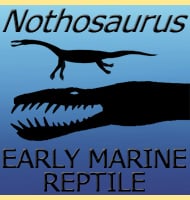Nothosaurus
In Depth Nothosaurus is representative of one of the dominant groups of marine reptiles of the Triassic, the other main group being the primitive ichthyosaurs like Cymbospondylus. The nothosaurs are often dubbed the seals of the Triassic because while they were adapted for aquatic life, they still held onto to clear terrestrial adaptations. This would … Read more
